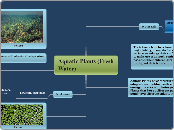Aquatic Plants (Fresh Water)
Water Lily
Structural/ behavioral adaptations
Their leaves tend to be broader without major lobing, to remain flat on water surface, to enlarge their surface area, and to make use of as much sunlight as possible. Their chloroplasts are found on the tops of their leaves.
Aquatic Plants have structural adaptations to obtain sufficient light energy to carry out photosynthesis. Plants that live at different parts of the pond have different adaptations.
Floating Plants - have adaptations to keep them afloat in order to carry out photosynthesis eg, Water Hyacinth, duckweed
Totally submerged plants - have adaptatons to help them float near the water surface in order to receive enough sunlight eg. Hydrilla
Paritally submerged Plants - although rooted to the ground, have leaves above the water surface so that it can receive enough sunlight, eg. Water lily

Picture
Structural/ behavioral adaptation
Elongates rapidly to reach water surface and branches out at water surface; more light can be obtained at water surface
Hydrilla
Duckweed
Structural adaptation
Upper Surface has a thick, waxy cuticle to repel water and to help keep the stomata open and clear

